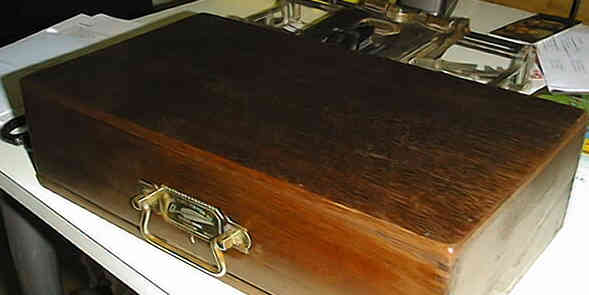The Hall Typewriter
The Case
Click
the Hall graphic to return to the Hall index page.
This website was never intended as a place for woodwork. But sometimes, it can just not be avoided. At some point we'll all run into a Hammond with a bad board, or a Blick with a damaged case. Same here. The original mahogany case that came with this Hall missed the top panel.
The challenge here was not how to fix it. Any book about restoring antique furniture will explain what you have to do. The problem here was finding the right piece of wood to do it with...


"I don't think he'll be willing to sell you that, even if he has it," she said and went on to repeat the same story. Antique wood is rare, so only if I would let them do the restoration, would he be willing to provide the wood.
I showed her the case, and a picture of the Hall, and at that point she got interested. She'd never seen one before, wanted to know how old it was, and how rare and she started giving me tips on where to find the wood.
"Yeah, well," I said, "I may end up having to buy a new piece, but that would show, wouldn't it."
"No, you shouldn't do that,"she said. "Hang on. I'll ask."
"He's coming. Don't take that as a good sign yet, but he's curious."
I displayed the case on a table, put the picture of the Hall next to it and waited. And there he was. He looked at it, looked at the pictures and was instantly enthousiastic. What a nice machine! How old is it? I've never seen one. He looked at the case and said: "Is it English?"
'No, American," I said.

He walked back into the workshop and started pulling pieces of wood from a rack. He came back in with a piece of dark mahogany and put it on top of the case.
I asked: "Does that mean you're also willing to sell it to me?"
"Sure," he said. "You're not going to find this in another million years. Give me 35 guilders (17 dollars)."
Next he started giving me tips on how to attach it and taking me around some of his mahogany furniture to let me feel how it should feel when I'm done.
Finally he gave me the piece of wood and said:`" There's just one condition."
"What's that?"
"When you're done, I want you to come back and show me this thing. I'd love to see it when it's ready."
Promise! I went home, sawed the piece to size and nailed and glued it onto the sides. After sanding it into a perfect fit and waxing it, it looks like this.